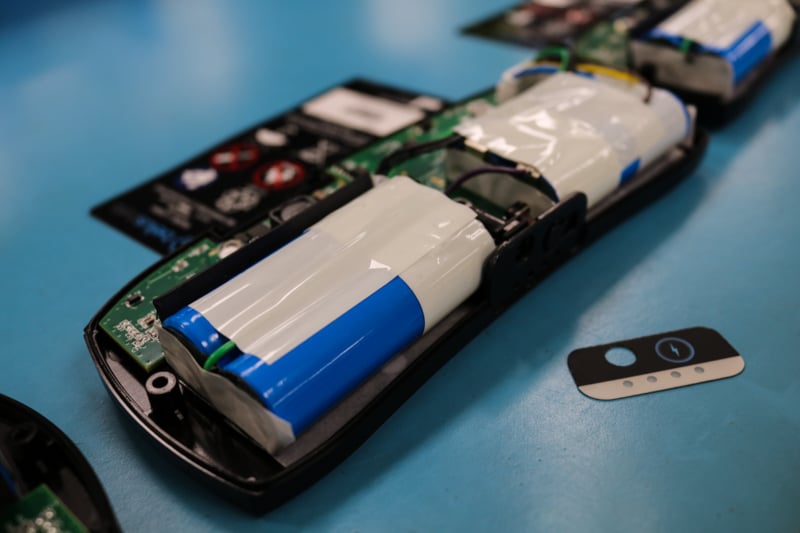New technologies, raw materials, and battery manufacturing have paved the way for new trends in custom battery pack designs. Many of these trends focus on making improvements to the battery's capacity and safety, while others redefine the testing standards implemented to ensure battery packs and chargers function optimally for consumers.
In this blog post, we will review some of the latest trends to know about when designing a custom battery pack for your application.
Silicon Anodes Batteries for Higher Energy Density
The lithium-ion battery market has grown exponentially throughout the decade and is expected to reach $135.1 billion USD by 2035. This significant increase in market demand from industries that include electric vehicles and renewable energy. Lithium-ion has been desired due to its higher energy density, its lightness, and the ability to be fast charged. As with all technology, battery manufacturers are continually looking to make improvements to lithium-ion batteries to improve capacity, self-discharge rates, and charging rates. One coming trend is the change to the anode in lithium batteries.

Custom lithium-ion battery pack during assembly.
Anodes typically are made with graphite materials. However, in the automotive industry, achieving higher energy density requires a larger lithium-ion battery. Larger batteries may add unnecessary weight to the product, or electric vehicle, which hampers efficiency. Battery and automotive manufacturers are investing in silicon anodes, silicon additives to graphite anodes, and silicon nanowires to graphite anodes. By adding silicon, it improves the performance and energy of the capacity by roughly 20% to 40% while also lowering the weight of the lithium battery by 15%.
Battery Chemistry Alternatives to Address Supply Chain Issues
Supply chains around the world have experienced issues in getting the raw materials to manufacturing plants that are necessary to make products. Two big reasons for this issue have been due to the COVID-19 pandemic and the Russia/Ukraine war.
Many operations had to slow production to keep workers safe, impacting production lines and increasing prices. Meanwhile, mines that produce cobalt, nickel, and lithium have been impacted by wars in countries that supply these metals. In the hopes to avoid future problems, manufacturers are looking into alternative battery chemistries such as sodium-ion, nickel-zinc, and lithium-iron phosphate.
Lithium-Iron Phosphate Batteries
Lithium-iron phosphate is not a new technology. It has actually been around since 1996. However, manufacturers preferred to use lithium-ion batteries over lithium-ion phosphate since the latter has a lower capacity, does not work well in colder temperatures, and were more expensive than lead-acid batteries.
Yet these types of batteries have started to gain in popularity for applications such as power tools and commercial vehicles as well as energy storage devices. The advantages of using lithium-iron phosphate have included a longer cycle life, large amounts of current for high-power applications, and their safety by posing a lower fire risk.
Sodium-Ion Batteries
Sodium-ion phosphate is still in the early stages of development, although it is a hot topic that many manufacturers are considering. Sodium is an abundant metal that can go through numerous charging/discharging cycles without experiencing degradation. These battery chemistries also are not as toxic as other chemistries and also self-extinguish safely.
However, like lithium-iron phosphate, sodium-ion still has low energy density when compared to lithium-ion. Manufacturers are trying to tackle this issue to bring more alternatives into the custom battery market.
Nickel-Zinc Batteries
Nickel-zinc has been around for nearly a century, yet this battery type has only been recently looked at more closely for its potential in the electric vehicle market as well as the microgrid industry. This battery chemistry offers a higher power density, reliability, and safety. It also offers a smaller footprint. Many manufacturers are looking at nickel zinc as an alternative to lead acid batteries used in data centers as the battery type in uninterruptible power supply (UPS) systems.
Solid State Batteries and Aluminum Enclosures
In addition to looking at possible alternative chemistries and ways to enhance cell power potential, the materials and structure of the battery pack is being constantly improved. Looking at the construction of the pack itself, most batteries today have a semirigid design to accommodate the wet electrolyte solution inside. Solid-state batteries (SSBs) are instead designed with hard materials that are tightly compressed. The SSBs offer varying advantages including the very low risk of thermal runaway, faster charging potential, and a higher energy density for electric vehicles of the same or smaller size.
When looking at the enclosure that will house the battery pack, many customers look for aluminum or plastic enclosures depending on the device and the application. Yet new trends in battery pack designs are seeing an increase in composite materials. Composite materials offer more of a lightweight design than aluminum and a sturdier structure when used for the lids. Expected demand for such materials is expected to increase in 2030 for use in electric vehicle enclosures.
Hybrid Battery Packs for Singular Solutions
Powering an application usually entails using the same type of battery chemistry throughout the pack. This aspect ensures that cells will have the same charging/discharging cycles as well as shelf life. An emerging trend has found that developers are taking a diversified approach by using multiple different chemistries within the same application. The reason for this trend is that developers want to take advantage of the varying benefits that each battery chemistry brings to the table.
One example is to have differing battery chemistries where some offer high power density for a short time while other batteries provide high energy density with low discharge rates. This hybrid approach may be used for applications such as microgrids and electric vehicle power stations that require peak power demands for both long and short durations. Applications that have fluctuating power needs can pull higher power when needed.
Federal Battery Testing Changes
Both manufacturers and customers may have heard earlier in 2022 about the proposed rule changes in regard to federal testing and certification requirements. In September 2022, the Department of Energy (DoE) released its Energy Conservation Program, Test Procedure for Battery Chargers rule. This ruling covers a wide variety of amended changes from previous requirements.
Here are some key aspects:
- Wet and dry fixed location wireless chargers that have a battery energy of 100 Wh will now undergo test procedures.
- Newly created section detailing no battery mode test methods that impact open placement wireless chargers.
- Requires battery charger testing using the EPS selection priority for batteries that are not shipped with the EPS.
- Prolongs the testing duration to capture maintenance mode power for specific battery chargers.
- Offers directions on how manufacturers can apply for a test procedure waiver when the energy in the battery cannot be measured.
- Many of the rule amendments are designed to improve readability as well as to reflect current market changes. These amendments can be found in Appendix Y of the program.
Summary
Battery pack manufacturers and customers should keep alert to the rising trends that will be impacting the custom battery design segment over the next decade. Many companies will be rolling out new battery chemistries or making improvements to existing chemistries that will also change the current federal testing and certification standards.
Key Takeaways
- Silicon anodes are boosting lithium-ion performance and reducing weight: By replacing or supplementing graphite with silicon, battery manufacturers are improving energy density by up to 40%, enabling lighter, longer-lasting battery packs, particularly valuable in electric vehicle and portable tech applications.
- Alternative chemistries are gaining traction to combat supply chain challenges: Sodium-ion, lithium-iron phosphate (LiFePO4), and nickel-zinc batteries are emerging as viable alternatives to traditional lithium-ion due to raw material shortages and rising costs tied to global geopolitical issues.
- Solid-state batteries and composite enclosures are shaping next-gen packs: With higher safety, energy density, and reduced thermal risk, solid-state batteries are paving the way for EV innovation. Meanwhile, composite enclosures offer a lightweight, durable alternative to aluminum, especially in high-demand applications.
- Hybrid battery packs combine chemistries for dynamic power delivery: Using multiple cell chemistries in a single pack allows devices to benefit from both high-power and long-duration energy delivery. This trend is particularly useful for microgrids, EV power stations, and systems with varying power needs.
- New federal testing standards reflect evolving battery technologies: Recent DOE rule changes include revised test procedures for wireless chargers, maintenance mode power capture, and no-battery-mode assessments. Manufacturers must stay current with these updates to ensure compliance.
















